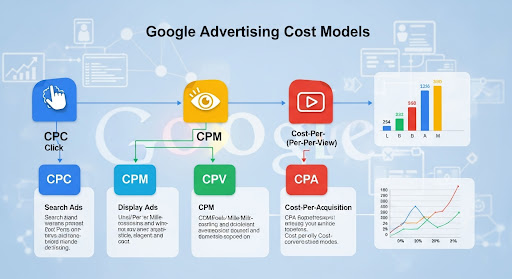
Welcome to the world of Google Ads! You know it's a powerful tool for attracting new customers, but the question of "how much does it cost?" is often the first and most critical one. If you've ever felt like your ad budget is a black hole, you're not alone. The secret to making your Google Ads spend work for you isn't just about setting a budget—it's about understanding the different cost models and choosing the one that aligns perfectly with your business goals.
Many businesses jump in with a "set it and forget it" mentality, which is a surefire way to overspend and underperform. The truth is, Google Ads isn't a one-size-fits-all platform. It offers a variety of cost models designed for different objectives, from simply getting more eyes on your brand to driving direct sales. Knowing these models is the first step toward a more strategic, and ultimately more profitable, advertising campaign.
This comprehensive guide will break down the most effective Google Ads cost models, explain the key factors that influence your costs, and provide you with a clear roadmap for making smarter decisions. By the time you're done reading, you'll be equipped to turn your Google Ads budget from a simple expense into a powerful engine for growth.
Google Ads operates on an auction-based system. This means you're bidding against other advertisers for ad space. However, how you pay for that space depends entirely on the bidding strategy and cost model you select. Let's dive into the three most common and effective models: Cost-Per-Click (CPC), Cost-Per-Impression (CPM), and Cost-Per-Acquisition (CPA).
Cost-Per-Click, or CPC, is the most widely used and well-known Google Ads cost model. As the name suggests, you only pay when someone actually clicks on your ad. This makes it an ideal choice if your primary goal is to drive qualified traffic to your website, blog, or a specific landing page.
With CPC, you set a "maximum CPC bid," which is the highest amount you're willing to pay for a single click. Google's ad auction system then determines your "actual CPC," which is often less than your maximum bid. This is calculated based on a combination of your bid, your competitor's bid, and a crucial factor we'll discuss next: your Quality Score.
When to use CPC:
The beauty of CPC is that you are only paying for engagement. You are not paying for an ad that is simply seen but not interacted with. This direct link between cost and action provides a clear way to measure the effectiveness of your ads in attracting potential customers.

CPM, which stands for "Cost Per Mille" (mille being the Latin word for thousand), is a cost model focused on visibility. With CPM bidding, you pay for every 1,000 times your ad is shown, or "impressed," on a webpage. This model is predominantly used for campaigns on the Google Display Network, where the goal is to get your brand in front of a wide audience.
Unlike CPC, a click is not the primary measure of success here. The goal is brand awareness and recognition. You want your brand's logo, name, and message to be seen by as many people as possible within your target demographic. There's also a more refined version called vCPM, or "viewable Cost-Per-Thousand-Impressions," where you only pay when your ad is actually considered "viewable" on a user's screen.
When to use CPM/vCPM:
CPM can be a highly effective way to build credibility and top-of-funnel awareness. While it doesn't directly track clicks or conversions, it's a vital component of a comprehensive marketing strategy.
For businesses that are laser-focused on results, Cost-Per-Acquisition, or CPA, is a game-changer. With this model, you set a target cost for a conversion, which could be a sale, a form submission, a phone call, or any other valuable action a user takes on your site. Google's algorithms then automatically adjust your bids in real-time to help you get as many conversions as possible at or below your target CPA.
This is a powerful, automated bidding strategy that takes the guesswork out of daily management. It leverages Google's machine learning to predict which ad auctions are most likely to result in a conversion and bids higher on those, while pulling back on less promising opportunities. The key to success with CPA is having enough historical conversion data for Google's algorithms to learn from.
When to use CPA:
CPA is the ultimate results-oriented model. It shifts the focus from clicks or impressions to the bottom line: paying for a specific, valuable action.
Understanding the cost models is just one piece of the puzzle. There are several other critical factors that will directly influence how much you pay, regardless of the model you choose. Knowing these factors is essential for managing your budget and improving your ROI.
The most direct driver of cost is the competition for a keyword. Highly competitive keywords like "car insurance" or "personal injury lawyer" will have a much higher CPC than more niche, or "long-tail," keywords. This is because many advertisers are vying for the same ad space, driving up the bid price.
For example, a search term like "personal injury lawyer" is highly competitive and has a high customer lifetime value, so advertisers are willing to pay a premium for a click. Conversely, a more specific, long-tail keyword like "best personal injury lawyer for slip and fall in Denver" may have less search volume but will be significantly cheaper and often convert at a higher rate.
This is perhaps the most important lever you have for controlling your costs and improving your ad position. Google's Quality Score is a metric that measures the overall relevance and quality of your ad, keywords, and landing page. It's scored on a scale of 1 to 10.
A high Quality Score signals to Google that your ad is highly relevant and helpful to the user. As a reward, Google gives you a higher Ad Rank and a lower CPC. A better Quality Score can reduce your costs by up to 30%, which is a massive difference in the long run.
The three main components of a Quality Score are:
By improving these three areas, you can directly influence your costs and get more for your advertising budget.
The industry you're in has a major impact on your costs. As mentioned, legal and financial services often have some of the highest CPCs due to intense competition and high customer lifetime values. On the other hand, industries like e-commerce or local services can have lower costs, but this can vary dramatically.
Your geographic targeting also plays a significant role. Advertising in a major metropolitan area like New York City or Los Angeles will be far more expensive than targeting a smaller, less-populated city. This is simply a matter of population density and competition.

The cost of advertising can also vary depending on where your ad is shown. Ads on the Google Search Network (the search results page) generally have a higher CPC because they are targeting users with high purchase intent. In contrast, ads on the Google Display Network (websites, apps, and YouTube) typically have a lower CPC, as they are focused more on brand awareness.
Similarly, the device a user is on can influence costs. Mobile traffic, which accounts for a significant portion of paid search clicks, may have a different CPC than desktop traffic. It's essential to analyze your data to see which devices are performing best and adjust your bids accordingly.
Now that you understand the different cost models and the factors that influence them, how do you choose the right one for your business? The answer comes down to your specific marketing goals.
For many businesses, a comprehensive strategy will involve a mix of these models. For instance, you might use a CPM campaign to build brand awareness with a cold audience on the Display Network, then use a CPC campaign to drive traffic from the Search Network, and finally a CPA strategy to retarget those visitors and drive conversions.
Navigating the world of Google Ads cost models can seem complex, but it doesn't have to be. By understanding the core models, CPC, CPM, and CPA, and the key factors that influence your spending, you can make informed, strategic decisions that lead to real business growth. The right model isn't just about what you pay; it's about what you get for that investment.
The most successful Google Ads campaigns are built on a foundation of data, strategic planning, and continuous optimization. You can’t just turn on a campaign and hope for the best. To truly unlock the power of Google Ads and achieve a positive return on your ad spend, you need an expert partner who can help you navigate this complex landscape.
Contact Finch for performance marketing that grows your business. We specialize in creating and managing data-driven Google Ads campaigns that deliver measurable results. Whether you're looking to drive traffic, increase brand awareness, or maximize sales, our team of experts can help you choose the right cost models, optimize your campaigns, and achieve your business goals.
The average cost-per-click (CPC) on Google Ads can vary dramatically depending on your industry, location, and keyword competition. While some benchmarks exist, like an average CPC of around $5.26 across all industries, this number can be misleading. Highly competitive industries like legal services can have CPCs well over $8, while others can be under $1. The key is to focus on your specific industry and target audience rather than a broad average.
The main difference lies in what you're paying for. With CPC, you pay for every single click on your ad, regardless of whether that click leads to a conversion or not. The goal is to drive traffic. With CPA, you set a target for the cost of a conversion (e.g., a sale or a lead), and Google’s algorithms automatically optimize your bids to achieve that goal. The primary focus of CPA is on the final outcome, not the clicks that lead to it.
Your Quality Score is one of the most powerful factors you can control to lower your costs and improve your ad position. It’s a rating from 1-10 that Google assigns based on the relevance of your ad, keywords, and landing page. A higher Quality Score (e.g., a 7 or above) signals to Google that your ad is very helpful to the user, and in return, Google will give you a lower CPC and a better Ad Rank. Essentially, a high Quality Score is your reward for creating a great user experience.
Yes, and you absolutely should. A successful, holistic marketing strategy often involves using a mix of cost models. For example, you might use a CPM campaign on the Display Network to build brand recognition, a CPC campaign on the Search Network to capture high-intent users, and a CPA campaign to retarget visitors who didn't convert and encourage them to make a purchase. This multi-pronged approach allows you to address different stages of the customer journey effectively.
There is no official minimum budget for Google Ads. You have complete control over your daily and monthly spending. You can start with a modest budget to test your keywords and ad copy. The key is to start small, monitor your performance closely, and then scale your budget based on the results you are seeing. A smaller budget may limit the amount of data you get, but it's a great way to learn without overcommitting financially.